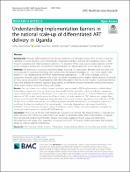| dc.contributor.author | Zakumumpa, Henry | |
| dc.contributor.author | Rujumba, Joseph | |
| dc.contributor.author | Kwiringira, Japheth | |
| dc.contributor.author | Katureebe, Cordelia | |
| dc.contributor.author | Spicer, Neil | |
| dc.date.accessioned | 2022-01-28T09:25:04Z | |
| dc.date.available | 2022-01-28T09:25:04Z | |
| dc.date.issued | 2020-03-17 | |
| dc.identifier.citation | Zakumumpa, Henry (2020). Understanding implementation barriers in the national scale-up of differentiated ART delivery in Uganda. Springer nature: BMC Health Services Research. https://doi.org/10.1186/s12913-020-5069-y. | en_US |
| dc.identifier.uri | https://doi.org/10.1186/s12913-020-5069-y | |
| dc.identifier.uri | https://kyuspace.kyu.ac.ug/xmlui/handle/20.500.12504/322 | |
| dc.description | 16 p. : col. | en_US |
| dc.description.abstract | Although Differentiated Service Delivery (DSD) for anti-retroviral therapy (ART) has been rolled-out
nationally in several countries since World Health Organization (WHO)‘s landmark 2016 guidelines, there is little
research evaluating post-implementation outcomes. The objective of this study was to explore patients’ and HIV
service managers’ perspectives on barriers to implementation of Differentiated ART service delivery in Uganda.
Methods: We employed a qualitative descriptive design involving 124 participants. Between April and June 2019
we conducted 76 qualitative interviews with national-level HIV program managers (n = 18), District Health Team
leaders (n = 24), representatives of PEPFAR implementing organizations (11), ART clinic in-charges (23) in six
purposively selected Uganda districts with a high HIV burden (Kampala, Luwero, Wakiso, Mbale, Budadiri, Bulambuli).
Six focus group discussions (48 participants) were held with patients enrolled in DSD models in case-study districts.
Data were analyzed by thematic approach as guided by a multi-level analytical framework: Individual-level factors;
Health-system factors; Community factors; and Context.
Results: Our data shows that multiple barriers have been encountered in DSD implementation. Individual-level:
Individualized stigma and a fear of detachment from health facilities by stable patients enrolled in communitybased
models were reported as bottlenecks. Socio-economic status was reported to have an influence on patient
selection of DSD models. Health-system: Insufficient training of health workers in DSD delivery and supply chain
barriers to multi-month ART dispensing were identified as constraints. Patients perceived current selection of DSD
models to be provider-intensive and not sufficiently patient-centred. Community: Community-level stigma and
insufficient funding to providers to fully operationalize community drug pick-up points were identified as
limitations. Context: Frequent changes in physical addresses among urban clients were reported to impede the
running of patient groups of rotating ART refill pick-ups.
Conclusion: This is one of the first multi-stakeholder evaluations of national DSD implementation in Uganda since
initial roll-out in 2017. Multi-level interventions are needed to accelerate further DSD implementation in Uganda
from demand-side (addressing HIV-related stigma, community engagement) and supply-side dimensions
(strengthening ART supply chain capacities, increasing funding for community models and further DSD program
design to improve patient-centeredness). | en_US |
| dc.language.iso | en | en_US |
| dc.publisher | Springer nature: BMC Health Services Research. | en_US |
| dc.relation.ispartofseries | ;No.222 | |
| dc.subject | HIV treatment | en_US |
| dc.subject | Health systems | en_US |
| dc.subject | Differentiated service delivery | en_US |
| dc.subject | Health services | en_US |
| dc.subject | Resource-limited settings | en_US |
| dc.title | Understanding implementation barriers in the national scale-up of differentiated ART delivery in Uganda | en_US |
| dc.type | Article | en_US |

